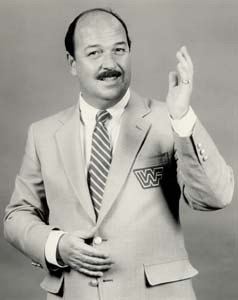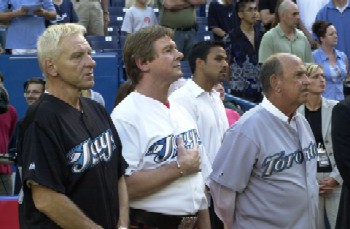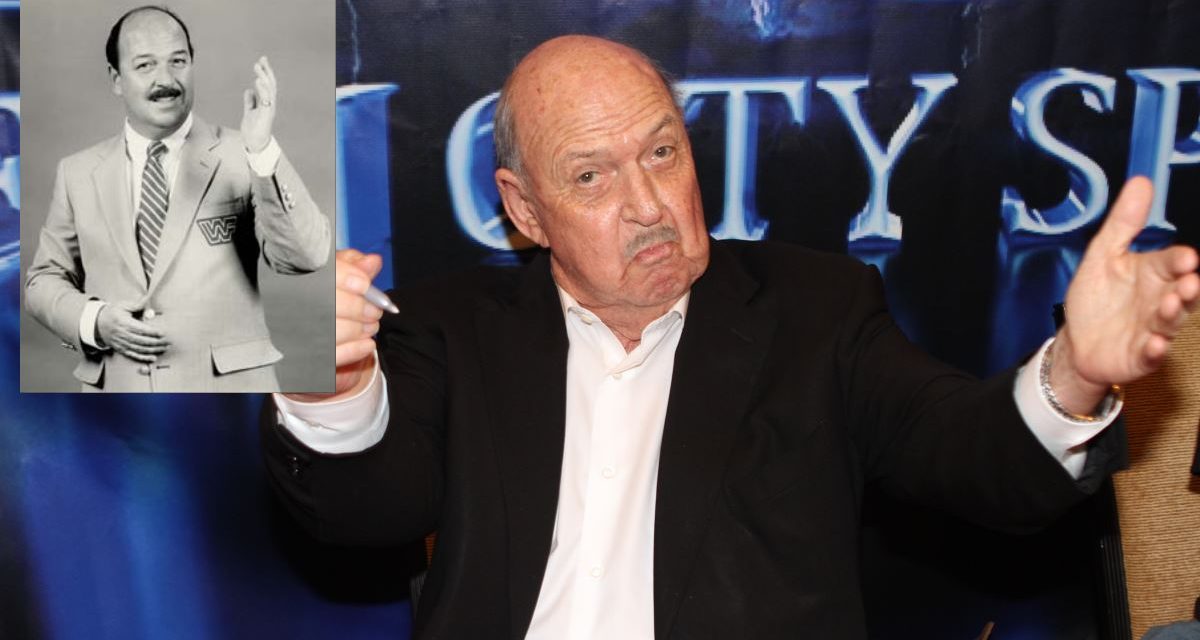His voice is unmistakable. Familiar and warmly comforting to any wrestling fan, his dulcet tones helped launch some of the most memorable interviews in the history of professional wrestling. And if WWE legend “Mean” Gene Okerlund has his way, he’ll be around for many more in the years to come. SLAM! Wrestling recently got a chance to talk to the dean of announcers about life in and out of the ring.
Gene Okerlund started his career in wrestling in Minnesota as the announcer for the now-defunct American Wrestling Association in the late 1960s. One fateful night, when the show’s regular announcer was off, Verne Gagne asked Gene to sit in; soon thereafter, Okerlund had a full-time gig. It was a lot different, he says, from what the future held in store. Compared to the current television product which is a full multi-media experience, Gagne’s show was very bare bones, making the announcer’s position a crucial one in helping move the show along.

“Mean” Gene Okerlund in his WWF heyday
“(It) was very crude television production — kind of a raw product. We had a very small TV studio which housed about 200 people, and we had no more than one or two cameras. And also the venues we played in back in the old days were different. We performed in high school gyms, and smoky national guard armouries. But you know what? It became effective, and I think a lot of it had to do with the interviews. I take a lot of pride in conducting these interviews because (they helped) paint the picture (for the viewers). You didn’t have a lot of the reinforcements and graphics on the screen. It was a lot different.”
As his recognition grew, Okerlund became the lead announcer for all of Gagne’s shows, including the one based out of Winnipeg, to where he would fly in on a weekly basis.
“I have a lot of great memories about Winnipeg, but I can’t share all of them with you here,” he says, chuckling. “(Back then, the city was a) very hot wrestling market, like Toronto is now. We’d go there in the middle of January, and people would plug their cars into a heating outlet and freeze their rear end off in 25-below weather to come see us. It was a different product (from the Minnesota shows) because we had to get into Canadian content rules, and had to shoot matches so that 51% of the show met Canadian content.”
In 1983, Gene was offered a spot with Vince McMahon’s World Wrestling Federation. Hesitant at first to give up his life in Minnesota, his intrigue in McMahon’s vision of the industry’s future outweighed any doubts that he may have had.
“I was reluctant to leave (the AWA),” he recalls. “(In addition to my job there), I also had an advertising and marketing business in downtown Minneapolis, with 40 or 45 people working for me, and things were going good. But Vince McMahon is a very persuasive individual. (What won me over was) the entire concept of what he was going to do, to bring the glitz and glamour and marry it with professional wrestling.”
Okerlund soon became the lead announcer for the company, picking up where he had left off with AWA, albeit now for a national audience. He became a globally-recognized figure, ever clad in a tuxedo and bow tie, holding the microphone for the most famous names ever to cut a promo. During the “Rock and Wrestling” heydays of the mid-’80s, it was a guarantee that Hulk Hogan would begin an interview with the immortal line, “Well, you know, Mean Gene …” before launching into a tirade against his opponent for the night. Okerlund is quick to credit Hogan for helping make him a household name.
“Certainly, I rode on the coat-tails of Hulk Hogan. If he was going to talk, I was going to be there holding the microphone. Over the years, (Hogan) certainly developed into one of the best stand-up guys going. He could really bring fans along — if you were there during that time, you knew that Hulkamania was for real.”
The wave of popularity that Hogan created paved the way for McMahon to take wrestling to entirely new heights, including creating Wrestlemania. Okerlund was thrilled to be part of the first one — not only as an announcer, but also to sing the national anthem to kick off the event.
Another of his favourite memories from those days is the huge outdoor event held at the CNE fairgrounds in 1986, where Hulk Hogan and Paul Orndorff main-evented in front of 70,000 fans. Titled “The Big Event”, it is, along with the record-setting crowd of Wrestlemania III, one of the largest attended wrestling shows ever in North America.
“A crowd like that was unheard of,” Okerlund recalls. “Even back in 1976 when they had a mega-show in Shea Stadium in New York, that wasn’t anywhere near what we had at the CNE show. It was a cool night, it got down to (near freezing temperatures). The boys would be sitting in the dugout to go out to the ring, and had to have a cup of coffee while waiting to keep warm.”
Okerlund was a staple at all of the company’s shows back then, traveling on the road with the wrestlers and living life out of hotel rooms nearly 300 days a year. While this might seem unusual — after all, not being a wrestler, one would think it wouldn’t matter if he was at house shows or not — he always considered his role as one that was important, notwithstanding the fact that he didn’t wrestle.
“I looked at myself as a support member to this team. I would try to make the transitions from the interviews to the issues to the big storylines, like the glue that held the (show) together.”
Gene’s tenure with the company came to an end in 1993 when he left for rival company WCW during the industry’s Monday Night wars. For WCW, taking away the recognizable character from the then-WWF was a huge coup. WCW’s strategy was to bring over stars like Hogan, Randy Savage, Okerlund and Bobby “the Brain” Heenan, names that were synonymous with the WWF, and put them on their own show. It would help the company steal away fans of those stars from WWF programming, and possibly get casual fans to watch as well, thinking that it was the same wrestling show they had always been watching.
The WWF responded to this looting by launching parody characters of the departed stars, mocking them by portraying them as old and tired characters from a bygone era. But even though ‘Scheme Gene’, a caricature of Okerlund, was portrayed as a bumbling fool, the real Gene never felt insulted.
“That didn’t bother me at all,” he says. “As a matter of fact, acknowledging the fact that ‘Scheme Gene’ was part of WCW actually gave me a compliment in a way, because it put me up there (in the same status) as the other stars that they parodied. (We, as part of WCW) put a pretty good dent in them for two years, and they had to counter the penetration that we took into the Monday night market.”
In WCW, Okerlund found himself playing a mentor role to some of the young, up-and-coming talent who might not have been as comfortable on the mic as some of the veterans he was used to dealing with in the WWF.
“We did not script anything in WCW. It was not quite as tight a product. A lot of the people that were coming up during that particular period of time didn’t go to the old school. So my role there became even more important, because I had to help some of the guys get through a complete thought about their upcoming match.”
Though he spent eight years with WCW, it was a welcome homecoming in 2001, when WCW was bought out by Vince McMahon. Okerlund was glad to be once again working for Vince, a man who he frequently traveled with in the ’80s, and names as a good friend.
“I always felt that some day I would get back home to (the company, which by this time was named) WWE. I have the utmost respect for Vince McMahon as a creative talent, as a very sharp businessman, but most of all, as a morally good guy.”
Picking up where he left off, Okerlund was named as the host of WWE Confidential, a quasi-news show that was more reality based than most of the company’s other programming. Though he still showed up at big events, like Wrestlemania 17, where he and his good friend Heenan provided guest commentary for the gimmick battle royal, he did not see himself becoming a regular on the Monday and Thursday night shows.
“I enjoyed doing Confidential, but the rigours of doing Raw and Smackdown 52 weeks a year probably isn’t the ticket for a 62-year-old guy who likes to play golf and take it easy. But I will be there for the big ones, and something I think I will be afforded for the rest of my life.”

Bobby Heenan, Roddy Piper and Gene Okerlund stand at attention for the national anthems at the July 20, 2005 Blue Jays-Mariners game. Photo by Mike Mastrandrea
Outside of the occasional guest appearance for WWE — SLAM! Wrestling conducted this interview during a three-day stint in the Toronto area, which included a visit at WWE Niagara Falls — Okerlund is quite happy with his other ventures as well. His famous name and face are behind the Mean Gene’s Burgers and Mean Gene’s Pizza food franchises, which have gained a strong reputation in the United States.
“I’d compare our pizza against any pizza company, from Pizza Hut and Domino’s to the local pizzeria. It’s a great product,” he says proudly.
The concept is expanding with the introduction of Mean Gene’s Beef Jerky later this year, and he is hopeful that they will make a big entry into the Canadian market as well.
“We’re making a very big move. I understand there’s going to be an acquisition of the parent company, by a Canadian trust. I look forward to spending some more time in Toronto (when that happens).”
He might even catch a few hockey games, now that the NHL is back in action after their cancelled season. A big fan of the sport — his son Todd played on the 1988 U.S. Olympic team and briefly for the New York Islanders in 1987-88 — Okerlund was glad to read the news reports when he was in town of the ending of the NHL lockout.
“It’s too bad that we were deprived of professional hockey. I didn’t think I’d see the day that they’d cancel a whole season, but it happened, and I think it’s going to take a while for things to get back up to where they need to be. The league and the owners will have do to something to get the fans back.”
With hockey to look forward to again, and the occasional golf game, Okerlund is very satisfied with his life at the moment. He still keeps up to date with wrestling as well, naturally, and finds the shows entertaining. And though he acknowledges that the role of the announcer has changed from his time, he has nothing but good things to say about the new generation of stick-men (and women).
“The announcer (used to be) kind of a grey guy. You had the (wrestlers, who were) black and white, good and bad, and the announcer was the neutral person in the middle. Back in the old days, everything kind of came off the top of the head. You had to make up the story, write it in your mind, and execute it.” Though he doesn’t see this as much today, what with scripted interviews and distinct personalities and characters being written for the announcers (Maria’s ditzy character for example, or the Coach who is a clear heel announcer), he doesn’t feel like the product is suffering as a result of that.
“You have to realize this is 2005, and a lot of things have changed. I don’t feel offended by it — I think it’s very entertaining.”
It’s clear when talking to Okerlund that he still cares deeply about the sport that he’s been involved in for the past 36 years, and it is this passion that he sees will keep him in it for many more to come.
“I’ve been asked ‘when are you going to retire?’ And my answer back is that I have no intentions of retiring. I want to do it like Gorilla Monsoon and take it straight to the end. I hope for health reasons that I’m able to do that (Okerlund had a major health scare in 2004, and had to have a kidney transplant). Other than the fact that I’ve recently run out Viagra,” he jokes, “right now, I feel great.”
RELATED LINK
“Bloodthirsty” Bob Kapur is proud of the fact that he refrained from imitating the Iron Sheik, Ric Flair, or Hulk Hogan and saying “Gene Mean”, “Mean Whoooo! Gene” or “Well you know, Mean Gene” even once while interviewing Mr. Okerlund. It was awful tempting.

